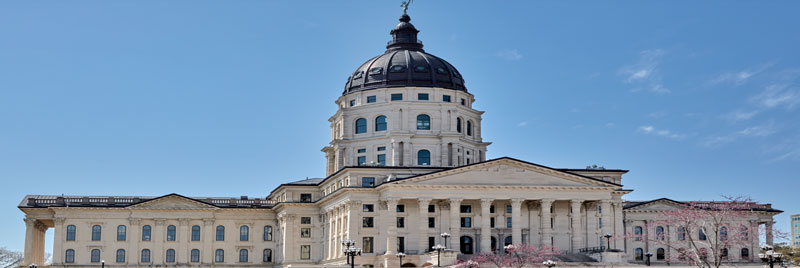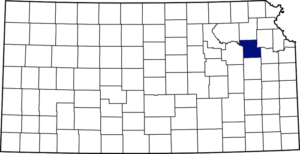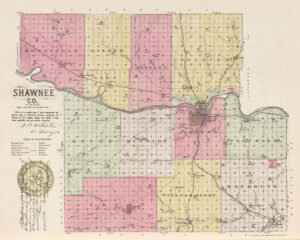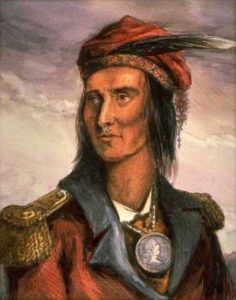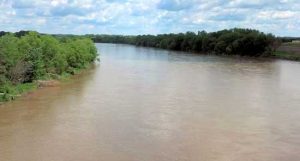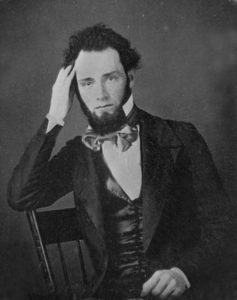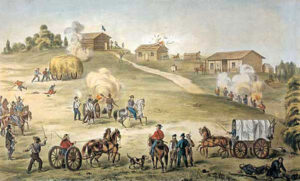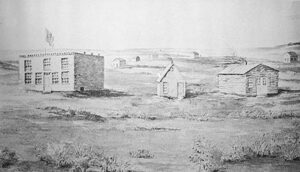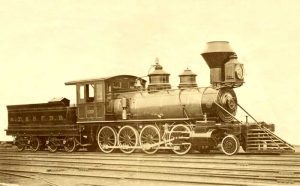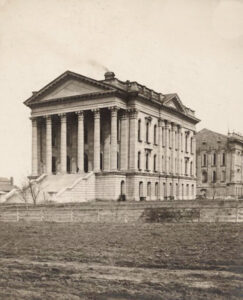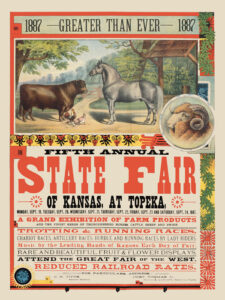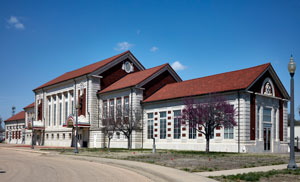Towns & Places:
Auburn
Berryton
Dover
Pauline
Rossville
Silver Lake
Tecumseh
Topeka – County Seat
Wakarusa
Willard
California Trail
Oregon Trails
Kansas River
Marais des Cygnes River
Native Stone Scenic Byway
One-Room, Country, & Historic Schools of Shawnee County
Pappan’s Ferry, Topeka
Shunganunga Creek
State Industrial School For Boys
Wakarusa River
Washburn University
Shawnee County, Kansas, was one of the original 33 counties created by the first territorial legislature in 1855. It is located in the northeast section of the state, the third county south of Nebraska and the third west of Missouri. It was named for the Shawnee Indians. Its most populous city, Topeka, is the state capital and county seat. As of the 2020 census, the population was 178,909, making it the third-most populous county in Kansas.
It is bounded on the north by Jackson and Jefferson Counties, on the east by Jefferson and Douglas, on the south by Osage, and the west by Wabaunsee and Pottawatomie.
Branches of the Oregon and California Trails crossed the county. Before 1847, the white people living here were missionaries or traders. The first trader was Frederick Chouteau, who established a post on the west bank of Mission Creek two miles south of the Kansas River in 1830. In the same year, Reverend William Johnson came to the Kanza Indian village, which had been established near the Chouteau trading post, and resided for two years. In 1835, the government farm was established in the valley of Mission Creek, and that year, the first plowing took place in the county. During the summer, mission buildings were erected on the northern part of the farm. This mission, together with Chouteau’s post, the government blacksmith, the government farmer, and a few other employees, constituted the first settlement.
In 1840, the three Papan brothers, whose wives were half Indian, were entitled to special reservations covering the site of North Topeka and came to that locality. Two years later, they established a ferry above the island on which the Topeka reservoir was later built. For many years, it accommodated the travel from Fort Leavenworth to New Mexico and that of the Oregon and California Trails. In the flood of 1844, all their houses, boats, and improvements of every kind were washed away. This flood was one of the worst in the history of the county. All the houses and improvements for miles on both sides of the river were destroyed, and the water on the site of North Topeka was 26 feet deep. The missionaries sent east for help for the white settlers and destitute Indians.

Pottawatomie Baptist Mission in Topeka, Kansas, courtesy Wikipedia.
Among the people who came in 1847 were Jonas Lykins, Father J.B. Hoecken, who established a Catholic mission in Auburn Township, a colony of settlers from Indiana, New York, and Iowa, located in Silver Lake Township, and another colony settled in Rossville Township. The following year, several settlers located in Soldier Township, Reverend Isaac McCoy and his daughter Elizabeth, and Reverend Robert Simerwell and his daughter Sarah, came to the Baptist Mission, established that year in Mission Township. They opened and taught an Indian school. The government established a trading post in 1848 at the site of Rossville, where Thomas N. Stinson, who later figured prominently in the history of Tecumseh, built the first house in March. Two months later, a dozen traders were located there, and the place was called Uniontown. The following year, cholera broke out among the Indians in the neighborhood, and the town was deserted except for Stinson, Whitehead, and McDonald, who remained with Dr. Gallimore and his wife to help check the disease, of which the doctor and his wife later died.
The Pottawatomie Baptist Mission building, built in 1849, still stands today. Located near the Kansas River on the California-Oregon Trail, it is one of the oldest buildings in the state and the only structure remaining from Baptist Indian mission activities in the state. It is off W. 6th St., one-half mile west of Wanamaker Road in Topeka, Kansas. It was listed on the National Register of Historic Places in 1971.
The county’s surface is a rolling prairie with a few hills and bluffs along the streams. Prominent among these is Burnett’s mound, one of the county’s beauty spots, located southwest of Topeka. The bottom lands along the Kansas and Wakarusa rivers were from one to three miles wide, and these, together with the creek valleys, comprised about one-third of the county’s area.
The Kansas River, the largest in the state, flows across the county from west to east, just north of the center. Its tributaries are Soldier Creek from the north and Mission Creek from the south. The Wakarusa River enters on the south line in the western part and flows east across the county into Douglas County.
Blue and gray limestone was found in the bluffs and along the banks of the streams. Clay for brick was plentiful, and coal was mined to a limited extent. The superior-quality sand was dredged from the Kansas River and shipped in large quantities. Timber belts along the streams contained oak, cottonwood, ash, walnut, hickory, hackberry, basswood, elm, mulberry, box elder, redbud, and ironwood. There were two medicinal springs at Topeka.
Tied to the founding of Kansas, the city of Topeka was established shortly after the Kansas-Nebraska Act was passed on May 30, 1854. In December 1854, nine settlers hailing from Pennsylvania, Massachusetts, New Hampshire, and Iowa met and established the townsite of Topeka. The following day, the men agreed, surveyed the land, and plotted the town site. They formed the Topeka Association and officially named the town in January 1855.
In 1855, the first territorial legislature organized the county and defined its boundaries. Tecumseh was made the county seat, and the following officers were elected: William O. Yeager, probate judge; William O. Yeager, Edward Hoagland, and William Yocum, board of commissioners; and George W. Berry, sheriff. In September, more officers were appointed to complete the organization, including John Martin, county clerk, and Thomas N. Stinson, treasurer. County buildings were erected at Tecumseh and paid for by the county and territorial tax.
Topeka was founded in 1855 by Colonel Cyrus K. Holliday and others.
Because Colonel Holliday had been elected to the legislature at an election ordered by Governor Andrew Reeder held on May 22, 1855, he was not seated, and the candidate elected by the Missourians and pro-slavery men on March 30 was seated in his place. The Free State citizens of Shawnee County did not recognize the acts of the legislature that convened at Pawnee that summer; hence, they did not consider the county organized. On these grounds, they refused to pay taxes, making it so unpleasant for the tax collector that keeping the same man in the office for more than a few weeks was impossible. The office of sheriff was not a popular one.
The whole territory was then in turmoil over the slavery question, and late in the fall of 1855, Shawnee County contributed to one of the free-state companies that went to the defense of Lawrence, which border ruffians and Missourians were besieging. This company was organized on November 27, with Daniel H. Home as captain. The following year, a company of Shawnee County men was organized under Captain William F. Creitz for protection against the raiders from Missouri and aided in securing a food supply that had been cut off from the free-state towns. It also marched to Bull Creek to repel Captain John Reid, a Missourian leading a raid on Osawatomie. Upon returning to Lawrence, Captain Creitz received word that Acting Governor Woodson had ordered Colonel Cooke to take possession of Topeka. The company hastened home in time to prevent this from happening again. In September 1856, about 50 Shawnee County men went to the assistance of General James Lane at Ozawkie. They were with him at the Battle of Hickory Point, later disbanding by order of Governor John Geary.
The first county election was held in October 1857, when the free-state ticket was elected as follows: Member of the council, Cyrus K. Holliday; representative, James A. DeLong; probate judge, Phillip Schuyler; sheriff, Jehiel Tyler; treasurer, A. Polley; register of deeds, F. W. Giles; surveyor, Joel Huntoon; commissioners, Harvey W. Curtis and Hiram Shields. After the election, it was found that under the territorial laws, the offices of sheriff, surveyor, and register of deeds were appointive instead of elective. At its first meeting in January 1858, the county board made Mr. Giles clerk of the board of commissioners, clerk of the probate judge, and register of deeds. Mr. Tyler was commissioned sheriff by the governor. The commissioners made Mr. Huntoon a surveyor. Edward Hoagland was appointed to the probate judge’s office in place of Mr. Schuyler, who declined to serve.
The new free-state officials found county matters in a state of chaos. No schools had been established, nor had any bridges been built; financial matters were in a desperate condition, owing to the building of the courthouse at Tecumseh and the failure to collect revenues; there was no jail, and no provision had been made to pay for the board of persons arrested by the sheriff. A bridge costing $900 was built over Deer Creek by county bonds issued by the commissioners, and the sheriff was authorized to issue certificates for the advance payment of taxes to meet the necessities of his office. In February, the county government was changed by the legislature so that each township had a board of commissioners, the chairman of each township board being a member of the county board. The first county board under this arrangement was Jeremiah Murphy, Eli Hopkins, P.T. Hupp, A. H. Hale, and George Bratton. Because the greater part of the county’s indebtedness was incurred in building a courthouse at Tecumseh without a vote of the people, and the organization of the county before the election of 1857 was spurious, the new county board repudiated the obligations incurred by the county before the first Monday in October 1857.
By an act of the legislature ordering the counties to vote on the location of their county seats in October 1858, an election was held in Shawnee County and resulted in the choice of Topeka. After considerable delay, Judge Hoagland announced the vote but declared the election “invalid and void.” Since the only thing that could invalidate the election was the delay in publishing the vote, the legislature removed the county seat from Tecumseh to Topeka by the special act of January 25, 1859, because the latter town was the people’s choice. No courthouse was built until after the Civil War, and on their removal to Topeka, the county offices were scattered all over town.
The first bridge over the Kansas River was built by a company organized in Topeka at private expense. It cost $10,000, was completed on May 1, 1858, and was swept away ten weeks later by high water. The first newspapers in the county were established in 1855. The Kansas Tribune was started at Lawrence in January and moved to Topeka the following December. The Kansas Freeman was started at Topeka on July 4. Both these papers were started as weeklies and later became dailies.
The first schools were organized in 1859.
During the Civil War, Shawnee County raised several companies to defend the Union and the State of Kansas. The Second Kansas state militia, mustered into service in 1864 to repel the Price Raid, was almost wholly a Shawnee County regiment.
After the war, which had arrested the county’s growth, the commissioners established schools, built bridges and roads, etc., which had begun in 1859. In 1865, a pontoon bridge over the Kansas River was built, which lasted till 1870. The following year, Mortimer Cook built a toll bridge purchased jointly by the city and county for $100,000.
The first railroad was the Union Pacific, completed through the county in 1866. Work was begun on the Atchison, Topeka & Santa Fe Railroad in the fall of 1868. The Union Pacific entered the county on the east line and crossed west, following the north bank of the Kansas River. The main line of the Atchison, Topeka & Santa Fe from Kansas City entered on the east line, crossed west to Topeka, and then south into Osage County. A branch of the Missouri Pacific Railroad from Fort Scott entered from the southeast and crossed to Topeka, where it terminated. The Chicago and Rock Island ran its trains over the Union Pacific tracks from Kansas City to Topeka, then over its tracks following the south bank of the Kansas River into Wabaunsee County. A line of this road extends north from Topeka into Jackson County.
In 1867, the citizens voted to build a courthouse and a jail, which cost nearly $69,000. The courtrooms occupied the second floor, the county offices were on the main floor, and the jail was in the basement. In 1886, a jail and sheriff’s residence were erected for $40,000. This courthouse was completed in 1895, and the cost of the site and building was $180,000.
The State Capitol of Kansas was constructed on a 20-acre tract donated to the state in 1862. The legislature authorized construction of the Capitol in 1866, and work soon began on the east wing. The cornerstone was laid on October 17, 1866, and the east wing was partially ready for occupancy by state officials in late 1869. The legislature met there in 1870, although the building was not entirely completed until 1873. Construction of the west wing began in I879, and it was first used by the legislature in 1881.
The State Capitol of Kansas combines French Renaissance and Corinthian-style architecture. The limestone building is cruciform in shape, with a high dome and rotunda to tie together the four wings.
Many different types of marble were used for the interior. The governor’s offices on the second floor are finished in white mahogany from Mexico. The ornate Senate chamber and the House of Representatives are on the third floor. The Senate chamber was decorated in 1885 for $300,000 and is regarded as one of the finest and most ornate legislative chambers in the country. The murals on the first and second floors are outstanding examples of Kansas art depicting the state’s development. It is located on four blocks between Eighth and Tenth Avenues and Jackson and Harrison Streets in Topeka.
In 1874, the Shawnee County Agricultural Society was organized, and it held fairs each fall for more than a dozen years at Topeka. Finally, the county fairs were so overshadowed by the state fairs held on the same grounds that they were discontinued. A state fair association was organized in 1880, and a state fair was held the following year on the county fairgrounds.
In 1882, there were 81 organized school districts, 91 schoolhouses, 133 schoolrooms with as many teachers, and an average attendance of 4,305 out of a school population of 11,496.
In 1895, the county voted for $150,000 for a new bridge, and the Melan bridge was built. It was one of the largest Melan arch bridges built when it commenced. It withstood a severe test in the flood of 1903, which swept away nearly every other bridge on the river. In 1905, the river’s channel was widened, and a new span was added to prevent damage by future floods. In 1911, another span was built.
In 1890, Shawnee County was prominent in the “Original Package” difficulty because the Federal court ordered the county attorney to discontinue actions brought against the violators of the Kansas prohibitory law, and the governor ordered the state attorney to appear in the place of the county attorney.
In 1910, there were 99 organized school districts, 338 teachers, and 16,994 people of school age, with an average attendance of 8,827 pupils.
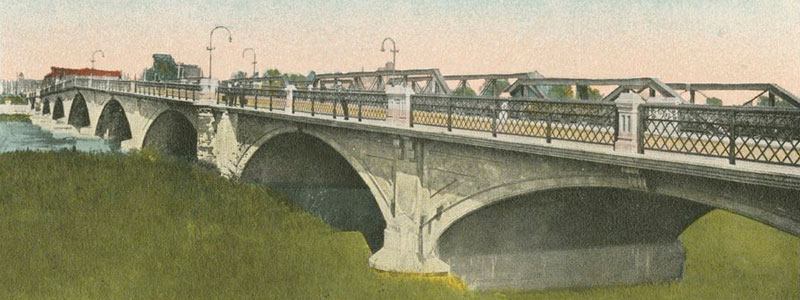
The Melan arch bridge opened over the Kansas River in 1898. Unfortunately, it collapsed in July 1965 and was soon replaced.
During the Spanish-American War of 1898-99, two full companies and parts of other companies were recruited in Shawnee County. Company A of the famous Twentieth Kansas was almost wholly recruited in Topeka, and the Kansas troops were mobilized at Camp Leedy, Topeka.
By 1900, the county had a population of 53,727
The disastrous flood of 1903 destroyed much property along all the county’s streams, especially the Kansas River and the Shunganunga. Less destructive floods occurred in 1904 and 1908. In 1911, the county built concrete dikes at Topeka to prevent a future overflow.
In the following decades, Shawnee County continued to grow. Some of the old towns became extinct, while others were established.
In July 1951, the Black Friday Flood swept down the Kansas River Valley into the Missouri River Basin, causing severe damage to Shawnee County and surrounding areas. The flooding began in June and continued into mid-July, when extremely heavy rains of 8 to 16 inches fell from July 9-13. These rains culminated in the highest river stages since the Great Flood of 1844. On July 13, the Kansas River crested at all official gaging stations, from Manhattan to Bonner Springs, 4 to 6 feet above all previously recorded crests. The Marais des Cygnes, Neosho, and Verdigris Rivers were also at or near crests, exceeding all previous records by as much as nine feet.
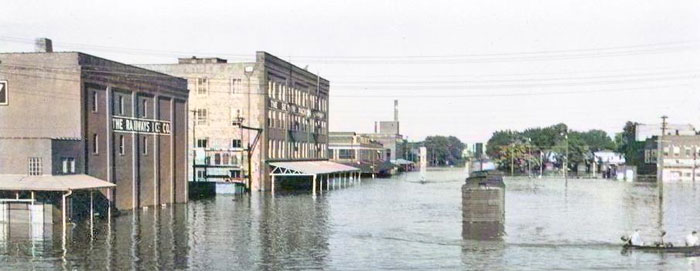
Topeka, Kansas Flood, 1951.
The flooding started above Manhattan on the Big Blue River. Downstream flooding continued in Topeka, Lawrence, and Kansas City. In Topeka alone, about 7,000 buildings were damaged or destroyed. The rising river waters caused transportation throughout the river basin to halt. Roads were washed away, and railroad tracks moved. Communication lines were down. Altogether, 116 cities and towns were affected; 85,000 people had to be evacuated; 22,000 homes were flooded, nearly 2,500 were demolished; 336 businesses were destroyed, and more than 3,000 were flooded. The flood claimed 28 lives as more than 1 million acres were flooded. Total losses in the Kansas River Basin, Kansas City, Missouri, and Kansas City, Kansas, exceeded $725,000,000.
Afterward, several flood control reservoirs and levees were built across Eastern Kansas. These systems prevented more widespread damage in many communities during the record rains and flooding of July 1993.
Shawnee County provides numerous recreational opportunities, museums, and historic sites today.
©Kathy Alexander/Legends of Kansas, updated June 2025.
Also See:
Sources:
Blackmar, Frank W.; Kansas: A Cyclopedia of State History, Vol I; Standard Publishing Company, Chicago, IL 1912.
Cutler, William G.; History of Kansas; A. T. Andreas, Chicago, IL, 1883.
Kansapedia
State Capitol – National Register Nomination

